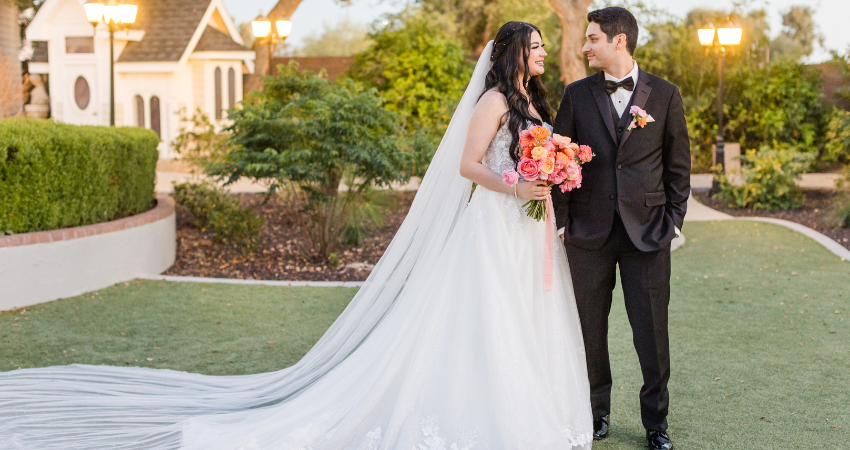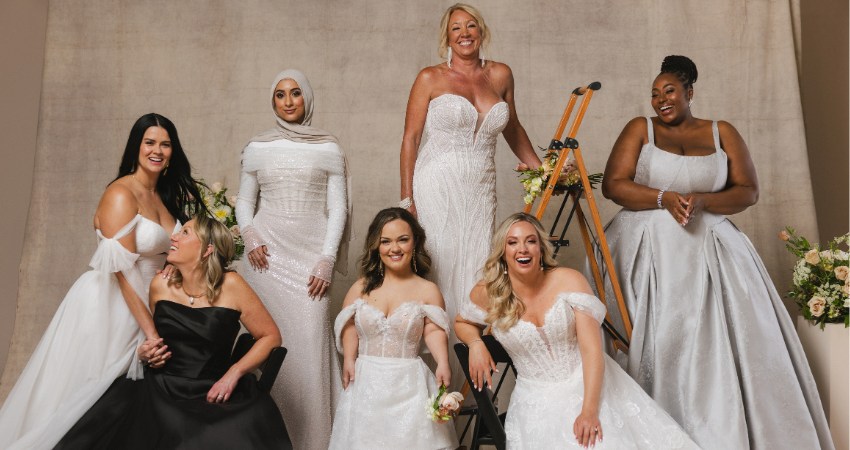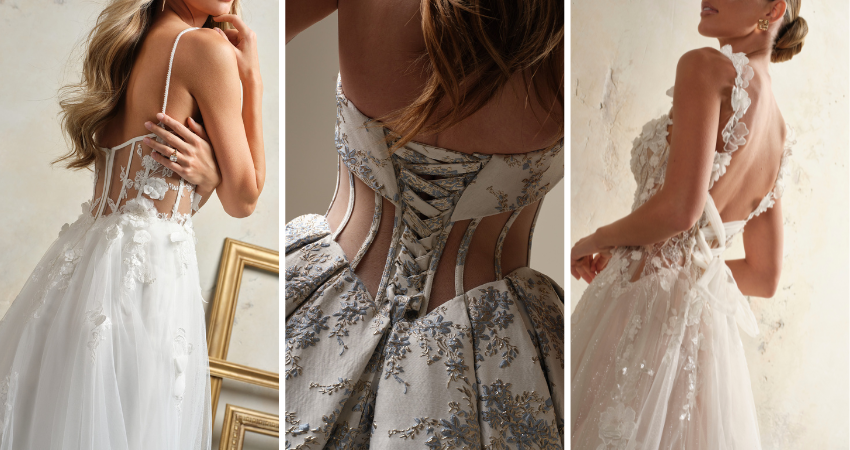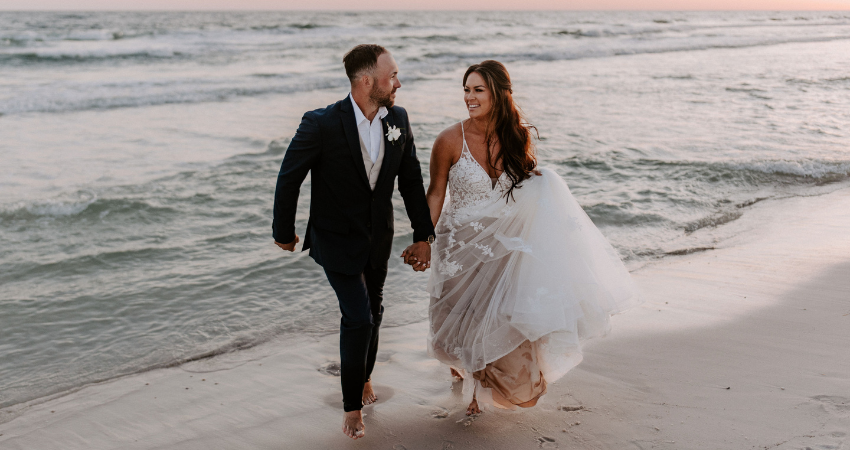Everything You Need to Know About Crepe Fabric Wedding Dresses
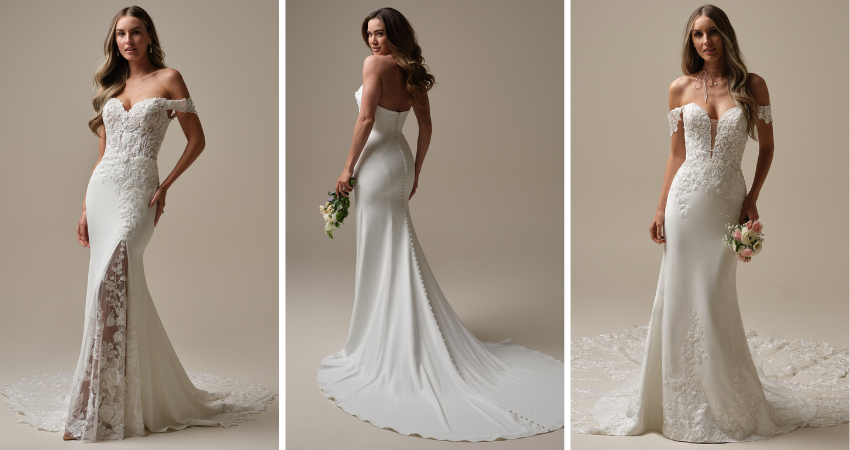
Just started shopping for your wedding dress? You may notice an array of sleek, chic, and ultra-flattering crepe styles dominating your social feed. To help you stay totally on trend and get to know this stunning bridal fabric, we’ve compiled our top FAQs about crepe fabric and the wedding dresses that go with it. Plus, we made sure to give you all the info you need on everything from material to wrinkling to proper undergarments! Keep scrolling and be sure to take our style quiz to make sure crepe matches your personal aesthetic and overall wedding vibe!
What is Crepe Fabric?
The word “crepe” can refer to a lot of different textures, weights, and draping styles of fabric. When it comes to wedding gowns, crepe styles are traditionally made from silk but can be made with almost any fiber. Thin crepe is typically crinkled and gauzy, while thicker crepe is smooth and elastic. Whatever the weight and texture of the crepe, it is typically a very luxurious choice of fabric for wedding dresses and romantic accessories.
A crepe wedding dress is typically smooth and luxurious. The fabric is used to create long and graceful silhouettes. It can be styled on its own for a clean and bright look, but most crepe wedding dresses are embellished with illusion, lace, and shimmer. This type of crepe is opaque, medium-weight, and figure-hugging.
Types of Crepe We Offer
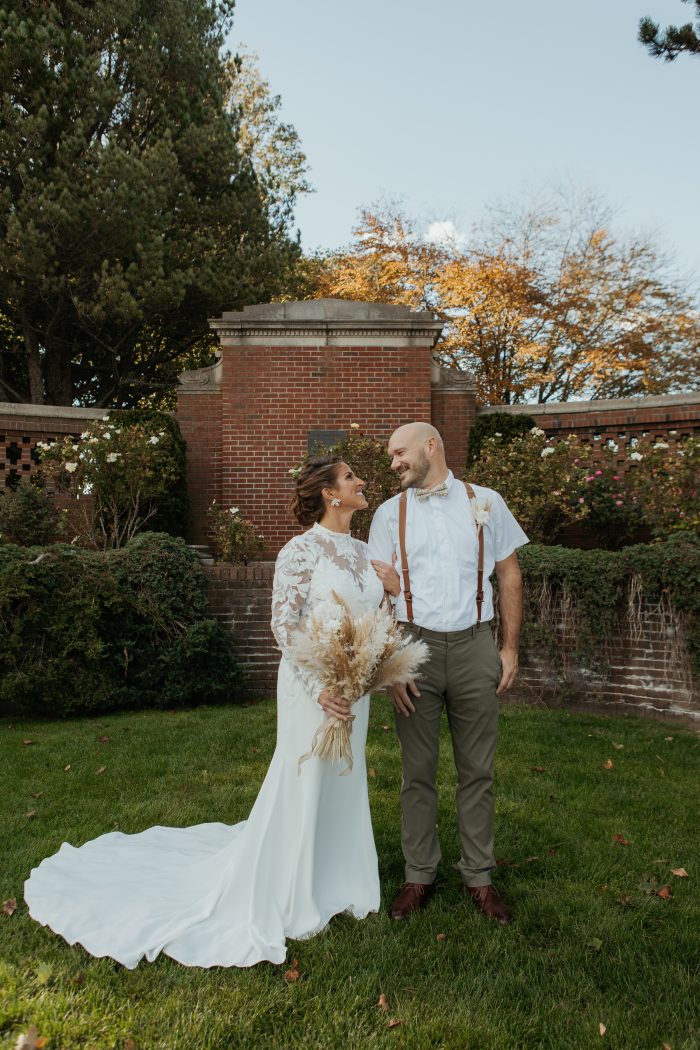
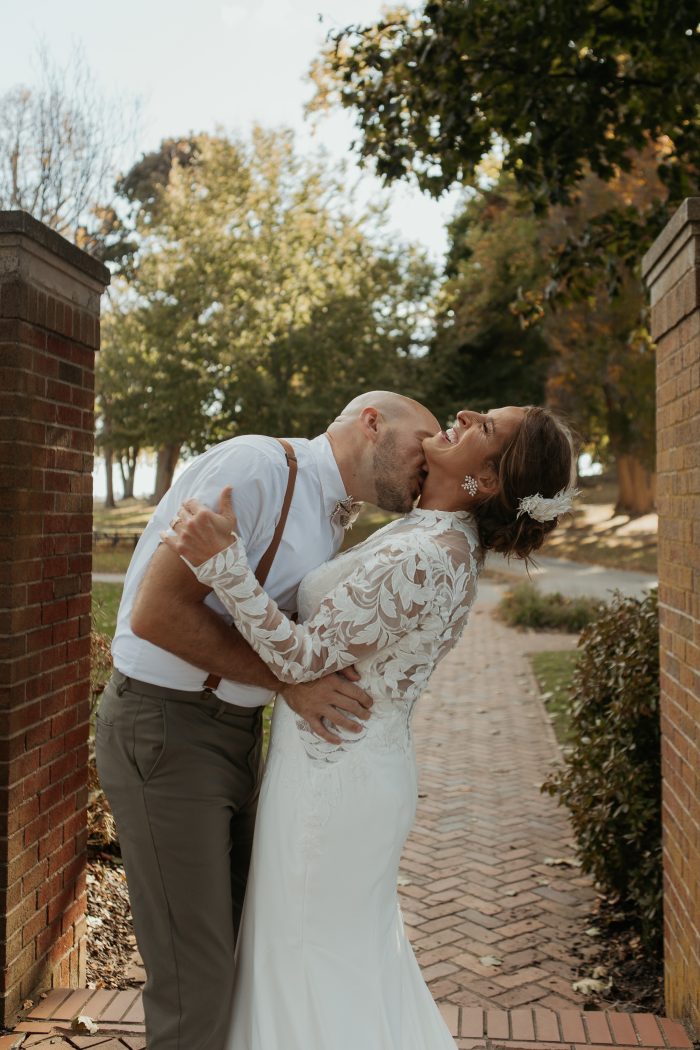
PC: Jess Biancardi
There are a lot of different types of crepe fabric to choose from for wedding dresses to complement your venue, season, and aesthetic. Some of the most common types that we offer are:
- Crepe Georgette: a thin, silk-like fabric with an elastic weave. It’s commonly used in evening wear and bridal gowns.
- Heavy Stretch Crepe: Structured crepe that is used often in formfitting silhouettes.
- Spandex or Scuba Crepe: Similar to a heavy stretch crepe, this smooth crepe is luxe, thick, and elastic.
Why Would You Wear a Crepe Fabric Wedding Dress?
The real question is why wouldn’t you?! Not only is crepe fabric comfortable, but it’s also chic as can be. Crepe wedding dresses come in almost any type of style from minimalist to fabulous, and summer to winter. A crepe wedding dress is a sleek, often minimalist-style gown made from a smooth and slightly stretchy draping. Crepe fabric is distinguished for its flowy yet striking appearance. Brides love it for its ideal thickness, comfortable elasticity, and versatility for embellishments.
The main attractions of a crepe wedding dress are its cool, contemporary feel and ultra-comfortable fabrication. Brides also love its striking contrast to embellishments, lighting, and venue settings. A crepe gown truly stands out!
Things Brides Love About Crepe
There’s a lot to love about crepe fabric. It’s smooth, chic, and super flattering, and perfect for a variety of silhouettes. Its thick texture makes it especially ideal for minimalist designs and fit-and-flare silhouettes.
Wedding dresses made with crepe fabric are light and breathable — perfect for outdoor weddings in warm weather. The fabric is flowy, figure-enhancing, and perfectly cut for relaxed yet formfitting designs.
Crepe is also super versatile. It comes in a variety of textures and folds styles to fit your vision and aesthetic.
Finally, crepe is a gorgeous choice for embellishments like lace, illusion, and crystals. Shimmery statement backs, bejeweled cuffs, and plunging necklines are often the highlight of a crepe material wedding dress.
Common Concerns About Crepe Wedding Dresses
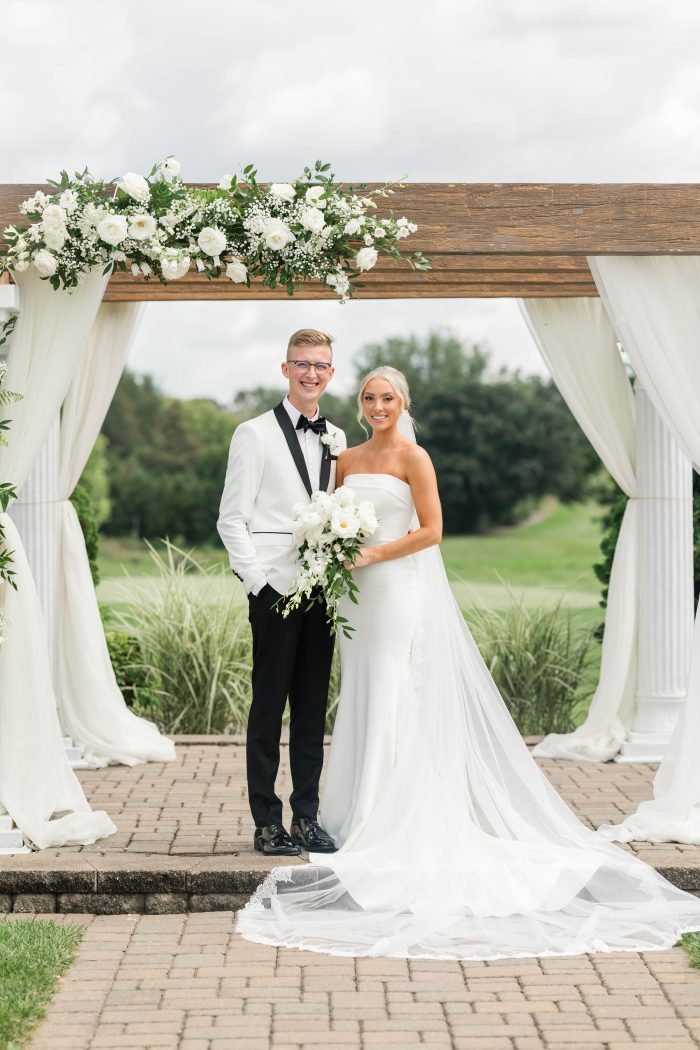
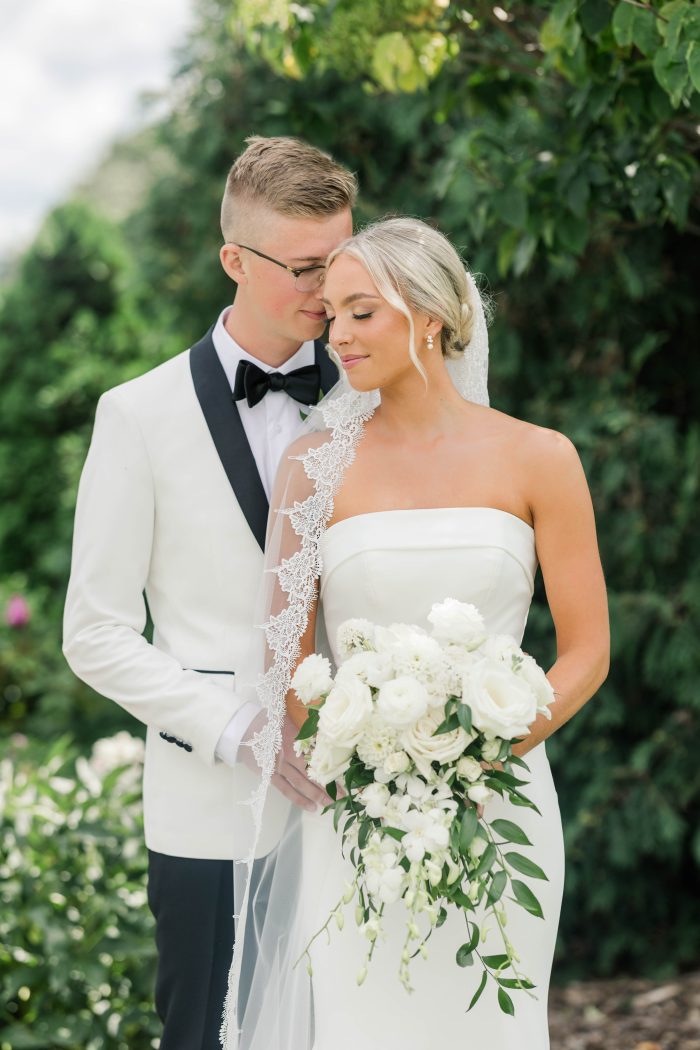
PC: Kelsey James Photography
Heavy crepe is better suited for fitted styles like mermaid and sheath. Less suitable for A-lines and ball gowns.
Lightweight crepe tends to be more airy, gauzy, and layer-able. It’s less suited for fitted silhouettes and better for fuller A-lines and ball gowns.
Your dress will show creases and imperfections underneath depending on how much spandex is incorporated into your crepe material. Avoid visible panty lines by choosing a stiffer, thicker crepe or by incorporating seamless shapewear.
Some brides dislike the feel of a thick crepe wedding dress for warm-weather weddings. They may prefer a gauzy tulle or airy chiffon.
What to Wear Under Your Wedding Dress
Wondering how to bring your head-to-toe look together with undergarments and shapewear? Here are a few things to keep in mind when choosing what to wear under a crepe gown:
- Depending on the thickness of the weave, a crepe fabric wedding dress is flattering, but it may need a little bit of support.
- Thicker fabrics are good for that “shapewear” effect, but thin and medium-stretch crepes would benefit from a trusty layer of smoothing undergarments.
Our favorite shapewear styles for a crepe wedding dress are:
- Shorts: mid-to calf-length depending on your gown’s silhouette.
- A Thong or Boy Shorts: good for an effortless summer look.
- Tummy Control: these help smooth and cinch in your waist — particularly helpful if your crepe wedding dress is a bit looser and silkier.
- A Strapless Front Bra: Great for low-back or illusion-back styles.
- A Full Catsuit or Bodysuit: An excellent choice for sleeved wedding dresses and cooler temps.
How to Care for a Crepe Wedding Dress
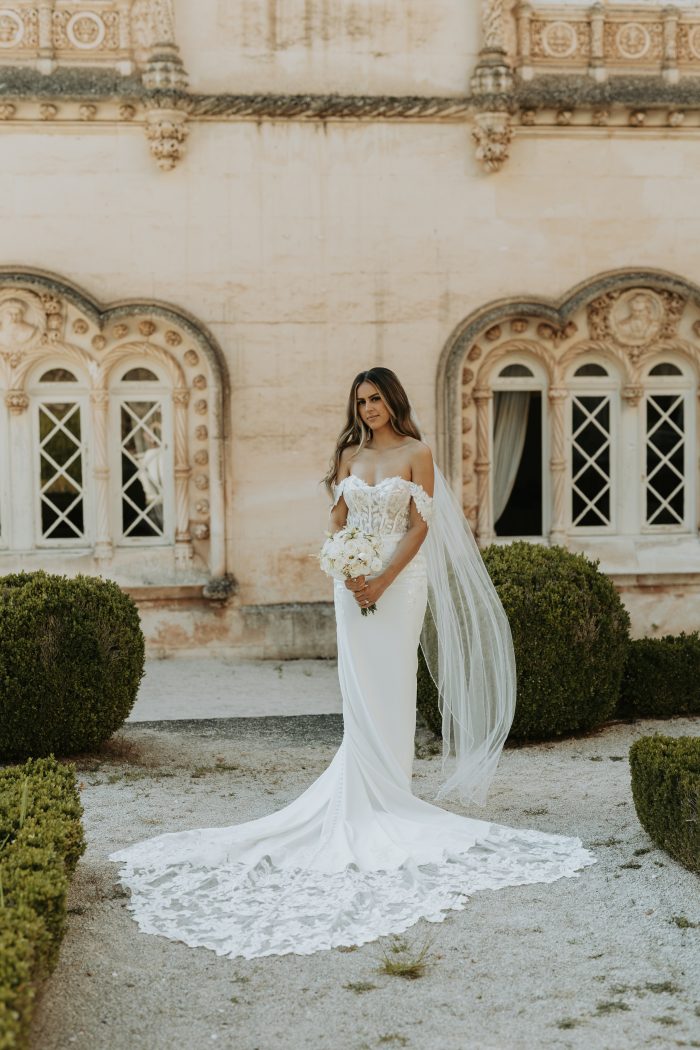
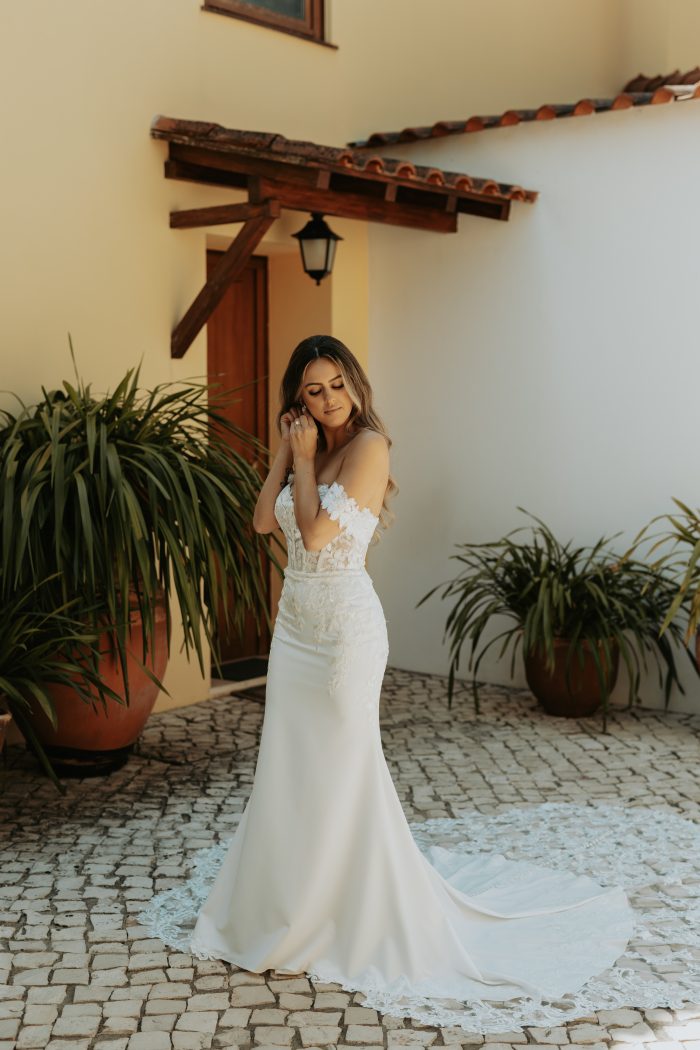
PC: Cameron House Photography
It’s easy to de-wrinkle your gown at home with a low-heat iron, garment steamer, or hot shower method if your crepe fabric wedding dress is made of polyester or stretch elastic. The most important part of this process is prevention. If you store your crepe with care, the less it will wrinkle and crease.
When the crepe does wrinkle, here are the best ways to restore its silhouette:
- Steam Your Dress: If you have one, a small hand-held steamer is all you need to smooth out wrinkles in crepe.
- Apply an Iron on Low Heat: Cotton and synthetic crepe (NOT silk) can typically be ironed on a super low setting. Check your clothing label, test a small area, and proceed carefully. Don’t Use the Steam Feature on Your Iron.
- Hang the Crepe Dress in Your Bathroom with the Hot Shower Running. This is an easy, gentle way to de-wrinkle your crepe. Hang your crepe fabric wedding dress on a clean hanger (preferably a fabric one; wood and plastic may put too much pressure on your gown’s straps), place it on the back of your bathroom door, and turn the shower water on high. Don’t put the dress on your shower rod. This is likely too close to the water stream and it may get wet. Run the water for about 20-30 minutes for the full steam effect.
- Let the Dress Hang. Once you’ve steamed or treated your crepe wedding dress, keep it hanging vertically. This lets the steaming set in and prevents the fabric from re-wrinkling.
- Avoid Stretching, Twisting, and Overheating Crepe. Wedding dress fabrics are delicate and sensitive to pressure. If you’re not careful with your de-wrinkling, you can end up creating uneven sections of color and texture in your gown.
Stunning Crepe Wedding Dresses
FAQs About Crepe Fabric
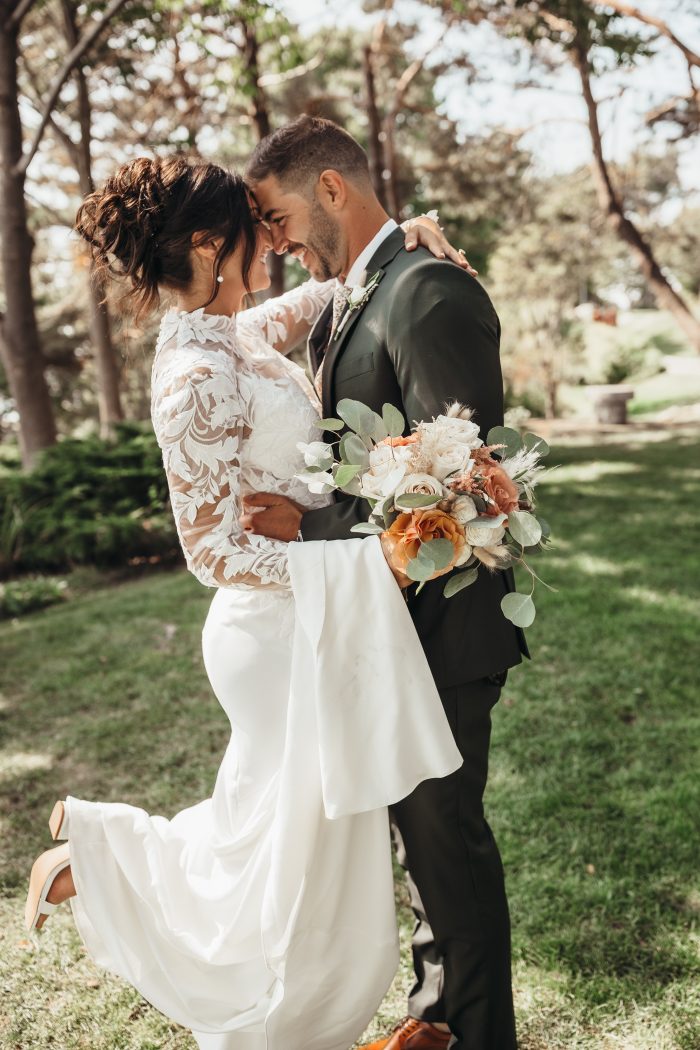
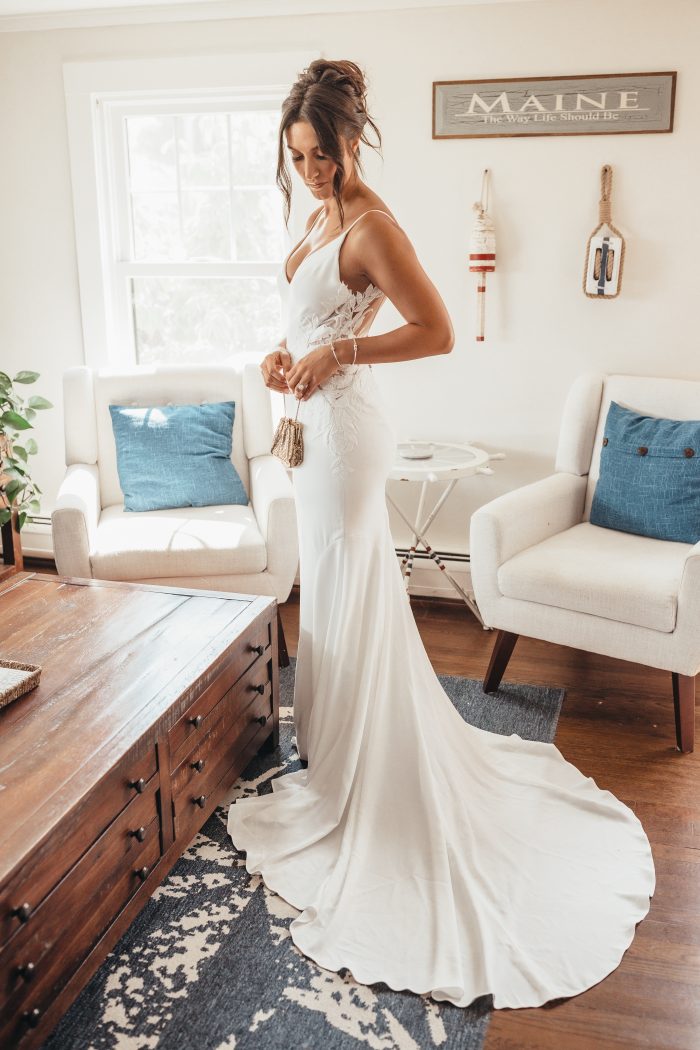
PC: A Nomadic Love
Let’s answer some last-minute questions about crepe wedding dresses!
Are these wedding dresses stretchy?
In short, yes! The heavier crepe fabric made for wedding dresses is usually more elastic and formfitting! However, if you get the more gauzy and silky kind it tends to be a little less stretchy.
Do these wedding dresses crease?
Not terribly! A crepe fabric wedding dress may need steaming when you first pull it out of the closet or garment bag, but its heavier weave helps to keep it in tip-top condition all evening long. The same applies to lightweight crepe… Your wedding dress will need some steaming to look photo-ready, but its crinkly texture helps to disguise new creases as the day goes on.
What kind of weave should I get?
The thinner the weave and texture of your crepe, the more likely it will wrinkle and crease — especially if folded away for long periods. Thicker crepe, on the other hand, holds its original shape and gives you a better chance of avoiding creases and wrinkles.
Loving all these crepe dresses? We have plenty more where these came from! Take some time to scroll through our collection of crepe wedding dresses and who knows? You might just find the one. Happy shopping, brides!
More Blogs Like This:
How To Choose Wedding Dress Fabric Weights
How To Care For Satin Wedding Dresses
The Ultimate Guide to Preserving Your Wedding Dress After the Big Day












